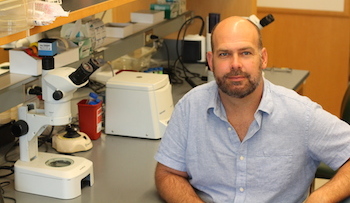 |
|
A gene that triggers remodeling of neural circuits in C. elegans during development has been identified by Michael Francis, PhD, associate professor of neurobiology. The study, details of which were published in Current Biology, is among the first to actively record rewiring of neural synapses in a live animal model, identifying the OIG-1 gene as a master regulator of this process.
This breakthrough provides scientists with a new understanding of how and when the circuits in the brain evolve during maturation. This could help researchers understand what happens when disorders with roots in the brain’s wiring, such as autism and Fragile X, cause changes to those circuits.
“It’s striking to watch,” said Dr. Francis. “We can actually see synaptic connections move from one position to another. This proved an important window that we could use to study neural remodeling and understand how this process is controlled. Through this process we were able to identify the gene OIG-1 as an important trigger in C. elegans brain development and circuit refinement. It’s exciting to envision that similar mechanisms may be at work in human brain development.”
As we mature, the connections in our brain go through an enormous amount of change and development, becoming more complex to encode our knowledge of the world around us. Part of this process entails some neuronal connections (synapses) being strengthened while others are weakened or eliminated. The process of synaptic refinement or remodeling is key for the development of nervous systems ranging from worms to humans, but the molecular mechanisms that control the specificity and timing of synaptic refinement are poorly understood.
The key to finding a window through which Francis and colleagues could record neural remodeling was the identification of a specific receptor in C. elegans neurons called ACR-12. ACR-12 is positioned at synapses in the nematode’s motor circuit and is responsible for receiving signals that help induce muscle relaxation or contraction associated with movement. By genetically tagging the receptor with a green fluorescent protein, Francis found he could use it as marker, watching as it changed locations within neurons during development. Because the nematode C. elegans is transparent, researchers could see the remodeling taking place in real-time in the worm under a microscope.
“We were able to define a window several hours after the worm larvae hatch in which neural remodeling occurred. We identified genes with high expression during this time window,” said Francis. “We then knocked out these genes one-by-one to identify one that played a part in neural refinement.”
These screens led Francis and colleagues to identify OIG-1, a member of the immunoglobulin (Ig) protein superfamily, as a key factor for proper execution of the neural remodeling program in C. elegans. “OIG-1 is highly expressed in the newly born nematode larvae. As nematodes age, these protein levels drop off, allowing remodeling to proceed,” said Francis.
To verify the association between OIG-1 and neural restructuring, Francis knocked out the gene entirely in some nematodes. As a result, these animals experienced neural maturation at a much earlier stage of development. “It appears OIG-1 expression inhibits this rewiring process,” said Francis. “When it’s absent remodeling takes place too soon. This suggests an interesting model of neural development. Synapses might have a higher capacity for relocation than we thought, and genes like OIG-1 might be necessary to suppress their natural tendency to move.”
Nematodes in which OIG-1 was knocked out were unable to move as well as their wild type counterparts. “From a physical perspective, it was as if these worms were unable to learn how to walk,” said Francis. “Developmentally they were unable to progress to anything beyond a crawl.”
Now that OIG-1 has been identified, the next step for Francis and colleagues will be to pick apart the molecular processes that govern how OIG-1 controls remodeling in hopes that a better understanding of this process in the nematode will shed light on how similar processes in the human brain occur.
Alison Philbrook, a graduate student in the Francis lab, was a first author on the study.